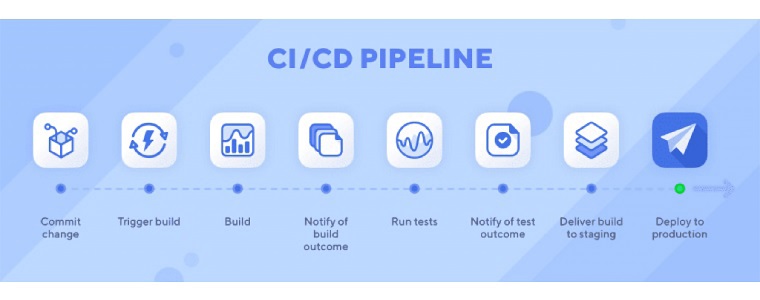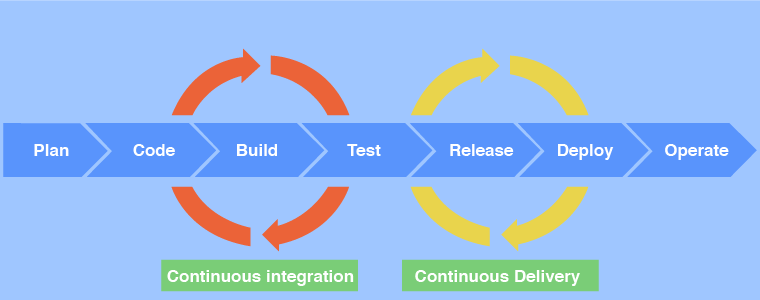
The CI/CD pipeline includes continuous integration, delivery, and deployment. DevOps teams use it to generate, test, and release new software automatically. This pipeline benefits from regular software changes and a more collaborative and agile team process. You have probably heard about the benefits of CI/CD tools that provide code more frequently and reliably. Let’s examine what it is and how it benefits software development.
There are two abbreviations for CI and CD: CI stands for continuous integration and CD for continuous delivery and deployment. Continuous Integration is the software development methodology based on the idea of making incremental code changes frequently and consistently.CI/CD (Continuous Deployment) is also based on this idea. Continuous Integration (CI)-triggered automated build and test stages ensure that code changes submitted into the source are trustworthy.
Integration, testing, delivery, and deployment are some of the processes that make up the CI/CD pipeline for DevOps services. It uses automated testing to identify potential problems earlier and test code changes in various environments. Automated testing covers nearly every aspect of pipeline quality management, including API performance and protection.
Software and app deployments will be more reliable, faster, and of higher quality due to the CI/CD pipeline’s ability to automate multiple stages.
A CI/CD pipeline should be set up before beginning the development process itself, as the parallel operation of CI/CD tools will fundamentally alter your workflow. You must first set up the pipeline phases correctly to make this happen. CI/CD Pipeline phases are now complete.

CI/CD helps companies deliver software on time and budget. It is now possible to bring products to market faster than ever before, ensuring a continuous flow of new features and bug fixes using the most efficient delivery mechanism. CI/CD enables an efficient procedure. Getting back to the point of this article, let’s identify the scenarios in which a CI/CD pipeline is most beneficial.
Quality assurance engineers use automated testing frameworks to write, execute, and automate various types of tests that inform development teams if a software build is successful or not. They create regression tests at the end of each sprint and combine them into a single test for the entire application.
It is important to note that this process does not stop there. Instead, it provides a quick and convenient way to automate processes beyond what was tested above.

Businesses that need a dependable way to regularly deliver updates to their apps design CI/CD pipelines. Organising builds, running tests, and automating deployments are all part of the production process for distributing code changes. Once a computing environment has been set up, a team can focus on improving apps rather than on the technical details of transferring them to the environment. As a result, developers may now push updates more frequently because of automation.
Learn More: DevOps Services of Metaorange Digital
A pipeline stage is a collection of CI/CD tasks organised into discrete subsets. Typical pipeline stages are as follows:

Source
CI/CD tools automatically apply modifications when changes are made to the code in the repository, which contains the initial source code repository. Other common triggers include user-initiated processes, scheduled timelines, and the results of other pipelines. The pipeline is started manually with a push request, which triggers the creation of Webhooks.

Build
At this point, an app is built from the ground up using the repository’s source code. Such programming languages as JavaScript and Ruby aren’t necessarily required to go through the build process. The failure to complete the build phase indicates a fundamental problem with the project, which should be addressed as soon as possible.

Test
The testing phase includes the development and execution of automated tests to verify the code’s correctness and the program’s functionality. To ensure the quality of the running code, this stage uses automation. Testing prevents repeatable problems from affecting customers. Before a release to the source code repository can occur, the Merge stage must be completed, which is done here.

Deploy
Finally, if all previous stages of testing and merging are completed without any conflicts or errors, the CI/CD pipeline is complete. When your code is deployed to a server like Azure or AWS, it’s ready to be used.
Continuous integration and delivery (CI/CD) is a never-ending development, testing, and deployment cycle. Test-driven development means that developers can react quickly to user feedback and improve their code. Everyone can change the code and solve problems quickly. This cycle allows developers to improve the initial code in the most efficient manner possible.
Faster time to market for new product features means more satisfied customers and less stress for developers. CI/CD pipelines enhance a company’s competitive advantage by allowing significant increases in total delivery speed. Using automation, teams engaged in continuous delivery and development can shorten the time to complete a project.
Finally, it is strongly recommended to incorporate Continuous Integration and Continuous Deployment (CI/CD) into your software development process to include complex subtasks. That’s all you need to know about how this will help you streamline and speed up your development process. In addition, you’ll benefit from automation, which will allow you to delegate all of your team’s duties so that they can focus on more important matters.
9 June, 2022
DevSecOps